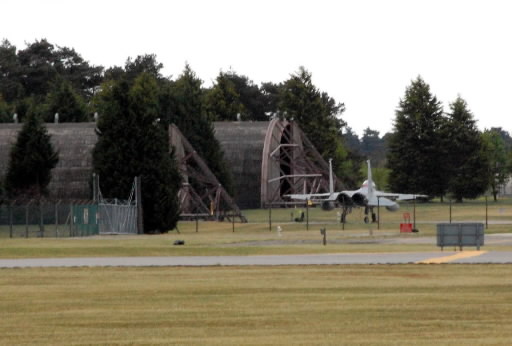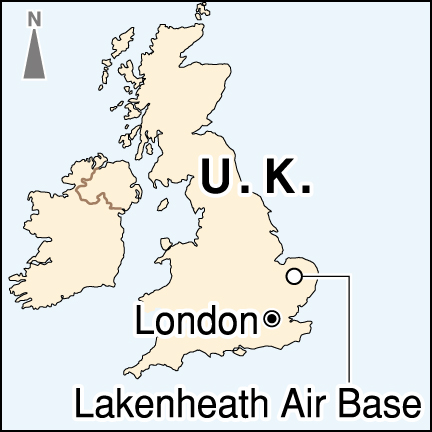Nuclear weapons can be eliminated: Chapter 4, Part 3
Jul. 15, 2009
Chapter 4: NATO's Cold War relics
Part 3: White elephants
by Yumi Kanazaki, Staff Writer
NATO shifts axis to Middle East
In one instance U.S. nuclear weapons have been removed from one of the air bases in Europe that serve as the hub of the nuclear strategy of the North Atlantic Treaty Organization (NATO). This took place recently at Lakenheath Air Base in the U.K.
Amid rolling hills in the countryside 110 kilometers northeast of London, people can be seen playing golf at a course that adjoins the air base, where U.S. Air Force F-15 fighter planes are stationed. Nuclear weapons were believed to be housed in underground vaults below 33 of the 66 hangars with semicircular-shaped roofs.
But the 110 B61 bombs that were said to have been stored here are believed to have been removed by June of 2008.
This was discovered by Hans Kristensen, 48, of the Nuclear Information Project at the Federation of American Scientists, who made use of the U.S. Freedom of Information Act and his own sources of information and found that Lakenheath Air Base was removed as the subject of on-site inspections for the safety of nuclear weapons.
Davida Higgin, 82, who formed the Lakenheath Action Group and who has been active in the anti-nuclear weapon movement, said she was overjoyed when she heard that the weapons had been removed. The group advocates non-violence, but Ms. Higgin was once arrested in front of the gate to the base. Because they have achieved their goal, they have halted their activities.
But concerns remain. “There are still many obstacles to the elimination of the nuclear weapons in this country,” Ms. Higgin said.
In Europe, both the U.K. and France possess their own nuclear weapons. And because U.S. nuclear strategy provides for the launch of nuclear weapons from the U.S. mainland or from nuclear submarines, the NATO area is under the U.S. nuclear umbrella. From the standpoint of Europe’s overall nuclear capability, the removal of the B61s, which are a tactical nuclear weapon, from the U.K. was a very small reduction.
According to Mr. Kristensen, the removal of the B61s in the U.K. followed similar removals from bases in Araxos, Greece in 2001 and in Ramstein, Germany in 2005. “NATO is shifting its strategic center to the Middle East, so there was no longer any point in having tactical nuclear weapons in far-off England or Germany,” he said. “And there are other issues more important than their nuclear mission.”
If they do not refuel, the range of fighter aircraft deploying B61s is limited within the boundaries of Europe. The deployment of NATO fighter aircraft and personnel in Afghanistan is more important and more practical.
NATO’s nuclear weapons can be said to be “white elephants.” The organization’s long-term policy, its Alliance Strategic Concept, which was adopted during the Washington Summit in 1999, simply states, “Nuclear forces based in Europe and committed to NATO provide an essential political and military link.”
This illustrates that nuclear weapons, which have lost their military significance, have been relegated to a vague “political” role.
(Originally published June 17, 2009)
To comment on this article, please click the link below. Comments will be moderated and posted in a timely fashion. Comments may also appear in the Chugoku Shimbun newspaper.









